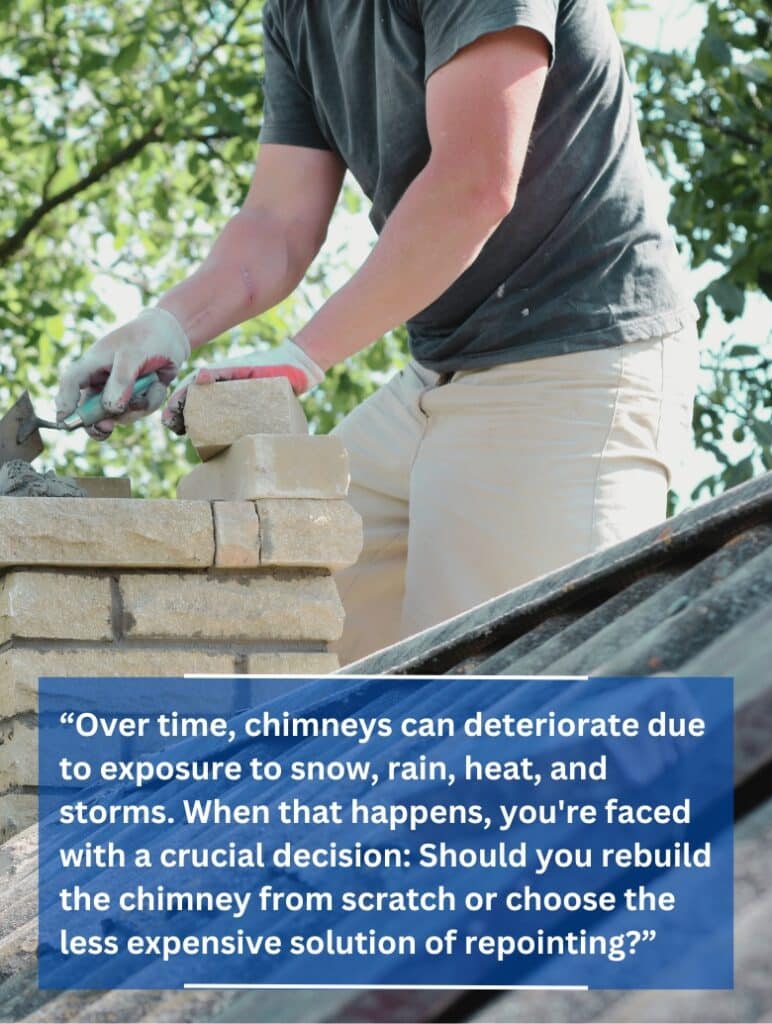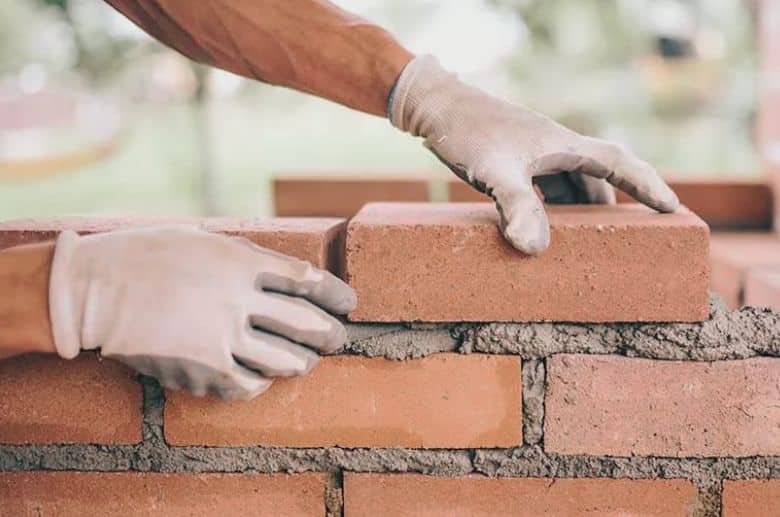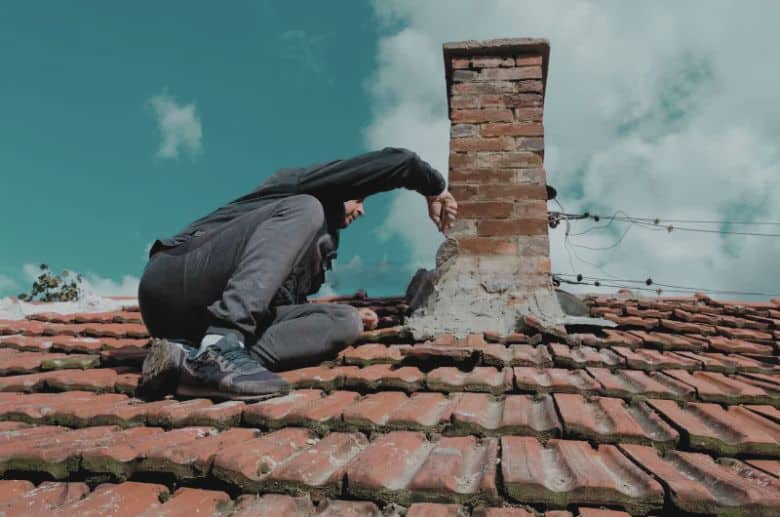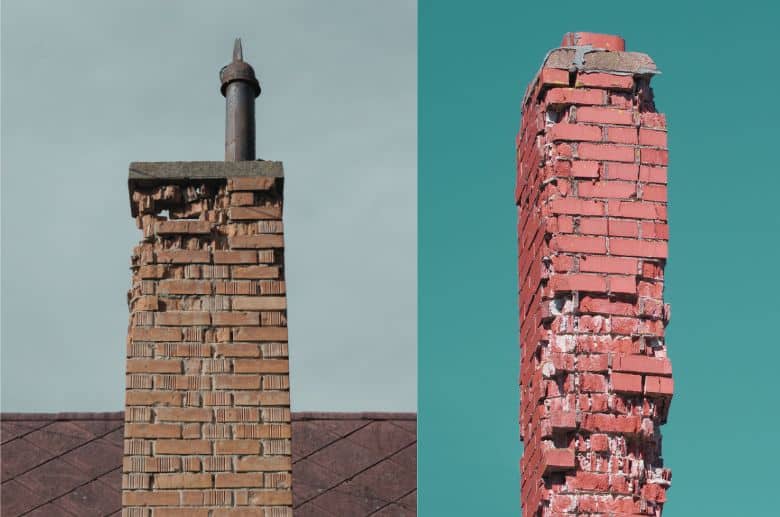Over time, chimneys can deteriorate due to exposure to snow, rain, heat, and storms. When that happens, you’re faced with a crucial decision: Should you rebuild the chimney from scratch or choose the less expensive solution of repointing?
Determining your best pick requires consideration and understanding of what these options offer. That’s why we’ve created this guide that looks at chimney rebuilding vs. chimney repointing—two essential processes you can apply to restore and extend the life of your chimney.
We’ll discuss each option to help you make the best decision.

——
Do You Need to Hire Chimney & Fireplace Expert?
Get free quotes from qualified experts near you. No commitment required!
——
What Does Chimney Rebuilding Mean?

Chimney rebuilding, unlike chimney repointing, is an extensive process that involves dismantling and reconstructing a chimney structure. This approach is necessary when the structural damage to the chimney is severe and cannot be effectively repaired through other methods.
Process of Chimney Rebuilding
The chimney rebuilding process is tailored to the extent of damage in your chimney structure. Depending on the severity of the issues, professionals will recommend either a partial or complete chimney rebuild to restore its structural integrity and safety.
A partial chimney rebuild is typically chosen when the damage is localized to a specific chimney section. On the other hand, when the damage to the chimney is widespread, affecting multiple areas or compromising its overall stability, a complete chimney rebuild is recommended.
For a partial rebuild, the damaged sections are carefully dismantled, and new masonry is installed to replace the compromised areas. Skilled masons match the new materials to the existing ones to maintain a cohesive appearance.
However, in a complete rebuild, each chimney layer is meticulously removed until the damaged portion is exposed. The rebuilding process involves constructing a new foundation and laying bricks or stones in the appropriate pattern to ensure stability and aesthetic consistency.
Signs That Rebuilding is Needed
Here are some unmistakable indicators that your chimney needs a complete rebuild:
- Extensive structural damage: Walk around your chimney and inspect it from all sides. Look for any noticeable leaning, tilting, or bowing of the chimney structure.
- Large sections of missing bricks or mortar: Examine the chimney closely for missing bricks or mortar joints. If you see sizable gaps or holes where bricks or mortar have deteriorated or fallen out, this is a clear sign that rebuilding is needed.
- Severe water damage: Look for discoloration, staining, or greenish moss or algae growth, which can indicate prolonged exposure to moisture.
- Deep cracks in the masonry: Pay attention to the depth and width of visible cracks. Deep, wide cracks are more concerning than hairline cracks. Use a flashlight to look inside the chimney, if possible, to check for cracks that may be hidden from view.
Pros and Cons of Chimney Rebuilding
As with anything else, there are advantages and disadvantages to going this route. However, sometimes a chimney is damaged so badly that you have no choice.
Pros
- Rebuilding provides safety assurance
- Enhanced longevity by extending the lifespan of your entire chimney system
- Aesthetic renewal by revamping the chimney’s appearance
Cons
- Rebuilding is a costly investment
- The process can be time-intensive
- Disruption to the home since you may require temporary evacuation or restrictions around the chimney area.
Cost Considerations for Chimney Rebuilding
Here are a few key cost-related factors to consider when contemplating chimney rebuilding:
Scope of Rebuilding
The extent of chimney rebuilding required plays a pivotal role in determining costs. A partial rebuild targeting specific damaged sections will generally be more budget-friendly than a complete rebuild.
Materials
Premium or specialty materials may come at a higher price. However, they make up for it with enhanced aesthetics and longevity. Balancing material quality with your budget is crucial in this regard.
Labor Costs
Labor costs vary widely based on factors such as location, the complexity of the rebuild, and the expertise of the professionals hired. Skilled masons may charge between $50 and $200 an hour or more for their services, but their experience can lead to a well-executed, durable rebuild.
Additional Repairs
Addressing underlying issues like damaged flue liners or extensive water damage during chimney rebuilding can significantly impact the overall cost. Typically, these additional repairs can range from $1,000 to $3,000 or more, depending on the extent of the damage and the materials needed for restoration.
Opting to tackle all necessary repairs simultaneously often proves more cost-effective in the long run. By bundling the chimney reconstruction with the required repairs, you can save 10% to 20% on the total expenses compared to addressing them separately.
What Does Repointing a Chimney Mean?

Although it may seem similar to tuckpointing, chimney repointing involves removing and replacing deteriorated mortar joints in the chimney’s masonry with new mortar color.
What sets repointing apart from tuckpointing is its focus on repair and restoration, rather than just the aesthetic aspect. While tuckpointing often involves applying a thin line of putty or mortar to create a neat appearance, repointing addresses the structural integrity of the chimney by renewing the actual mortar joints.
Neglected chimney maintenance is prevalent in the United States, contributing to approximately 14,000 chimney fires annually. Therefore, homeowners must prioritize the well-being of their chimney, and one highly effective method for ensuring its efficiency and safety is through chimney repointing.
Steps in the Repointing Process
Repointing begins with thoroughly inspecting the chimney to identify damaged or deteriorated mortar joints. A skilled chimney contractor assesses the extent of the damage and determines the appropriate course of action.
The area around the damaged joints is cleaned, and loose debris is removed. This ensures a clean and stable surface for the repointing process.
The old, damaged mortar is carefully chiseled out without harming the surrounding bricks or stones. The professional then prepares a mortar mix that closely matches the original. This ensures a seamless blend with the existing masonry.
The new mortar is then applied to the cleaned-out joints using specialized tools, such as pointing trowels. After the mortar sets, excess mortar is smoothed away to achieve a uniform and visually pleasing finish.
Signs That Repointing is Needed
The following are signs that your chimney requires repointing:
- Deteriorating mortar joints: Run your fingers over the joints; if the mortar feels sandy or easily flakes away, it’s a sign that repointing may be necessary.
- Loose bricks: Gently tap each brick on your chimney with a small mallet or the handle of a screwdriver. If you hear a hollow sound or notice that some bricks move slightly or feel loose, they may need repointing.
- Water infiltration: Keep an eye out for signs of water infiltration inside your home near the chimney, such as water stains on the ceiling or walls, dampness, or mold growth.
- Gaps and voids in the mortar: Examine the mortar joints between the bricks for gaps, cracks, or voids. If you can see spaces between the mortar and bricks, it suggests that the mortar is no longer properly sealing the chimney, allowing for potential water and structural damage.
- Cracked or crumbling mortar: Look for cracks in the mortar joints, which can often be visible on the exterior surface of the chimney.
——
Do You Need to Hire Chimney & Fireplace Expert?
Get free quotes from qualified experts near you. No commitment required!
——
Pros and Cons of Chimney Repointing
Again, with chimney repointing, there are advantages and disadvantages.
Pros
- Repointing preserves the structural integrity of the chimney
- Enhances aesthetics
- Prevents water damage
Cons
- Repointing can be relatively expensive
- The process is labor-intensive
- Repointing may not resolve underlying structural problems
Cost Considerations for Chimney Repointing
The expenses associated with chimney repointing can fluctuate based on several influencing factors:
Chimney Size
Larger chimneys with more mortar joints require more time and materials, leading to higher overall expenses for the repointing project. This is unlike smaller chimneys that would require less time and materials.
Masonry Condition
Extensive deterioration and additional repair needs, such as loose brick reattachment, can increase the overall cost of repointing. These additional repairs may range from $500 to $2,000, depending on the extent of damage.
Labor Fees
Labor costs for repointing vary widely based on several factors:
- Location: In urban areas, labor costs may be higher, typically ranging from $40 to $80 per hour.
- Complexity: A straightforward repointing job may cost between $1,000 andto $3,000, while more complex projects with intricate designs or hard-to-reach chimneys can range from $3,000 to $6,000 or more.
- Mason’s Experience: Skilled professionals may charge a premium, but their expertise ensures a quality repointing job. Expect to pay between $1,500 and $4,000 for labor, depending on the mason’s experience and reputation.
Chimney Rebuilding vs. Chimney Repointing: Key Differences

When faced with chimney maintenance needs, you must consider rebuilding or repointing. The decision hinges on several critical factors, each with implications for your home and budget.
The Extent of Damage Addressed
Chimney repointing primarily addresses issues related to the mortar joints, such as deteriorated or cracked mortar. It’s ideal for cases where the chimney’s structural integrity remains intact and the damage is relatively minor.
On the other hand, chimney rebuilding is a comprehensive solution when the structural damage is extensive, affecting the mortar joints, bricks, stones, or even the chimney’s foundation.
Cost Implications
On average, you can expect to pay between $500 and $2,000 for chimney repointing, with larger or more complex chimneys on the higher end of the cost spectrum.
On the other hand, chimney rebuilding is a much more extensive and costly option. It involves dismantling the existing chimney and reconstructing it from the ground up. On average, you can expect to pay anywhere from $4,000 to $15,000 or more for chimney rebuilding, making it a substantially more expensive option than reporting.
——
Do You Need to Hire Chimney & Fireplace Expert?
Get free quotes from qualified experts near you. No commitment required!
——
Duration of the Project
Repointing projects are typically shorter in duration compared to chimney rebuilding. It may take a few days to a week to complete the project, depending on the chimney’s size and the extent of mortar damage.
Conversely, chimney rebuilding, especially complete rebuilds, can take several weeks or longer, leading to more disruption and inconvenience.
Impact on Property Value
Both chimney repointing and rebuilding can positively impact property value. Repointing enhances the appearance and functionality of the chimney. On average, a well-executed chimney rebuilding project can add up to 5% to the property’s value, depending on the region and market conditions.
On the other hand, chimney repointing may increase a property’s value by around 1-2%. The actual percentage can vary based on factors like the extent of repointing required, the condition of the chimney, and the local real estate market.
Rebuilding allows for more significant alterations to the chimney’s appearance and can achieve a fresh, customized look. Here’s a quick summary of the differences between chimney rebuilding and repointing:
| Aspect | Chimney Rebuilding | Chimney Repointing |
| The extent of Damage Addressed | Extensive | Moderate |
| Cost Implications | $4,000 to $15,000 | $500 to $2,000 |
| Duration of the Project | Weeks to Months | Days to Weeks |
| Impact on Property Value | Positive | Positive |
When to Use Each Method
Chimney repointing is typically used when the chimney exhibits signs of mortar deterioration, such as cracks, gaps, or crumbling mortar joints. Chimney rebuilding is used when structural damage is extensive. It’s also suitable for severe water or fire damage that compromises the entire chimney structure.
Is It Better To Rebuild or Repoint a Chimney?
When choosing between chimney rebuilding and repointing, consider all the variables. To empower yourself with the knowledge needed to make a wise decision, consider the following:
Consult a Professional Chimney Specialist
A chimney business with strong experience can conduct a thorough inspection, accurately evaluate the condition of your chimney, and provide expert advice on the most suitable solution and a solid estimate.
Their assessment will consider factors such as the severity of damage, helping you make an informed decision.
Conclusion
Overall, promptly addressing chimney damage is paramount to ensure your home’s chimney’s safety, structural integrity, and longevity. Both rebuilding and repointing offer invaluable benefits, but the right one will eventually depend on the extent of damage to your chimney.
Also, we highly recommend you consult a professional chimney specialist to provide expert guidance. This will ensure you select the most appropriate and cost-effective solution to safeguard your chimney and home.






